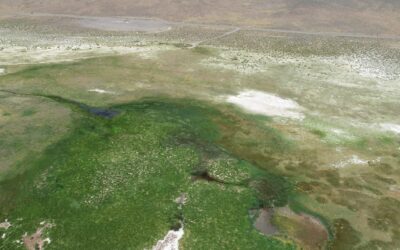Researchers analyzed evidence of global population change spanning 30,000 years to uncover the impact of disturbances on humans and the factors affecting their resilience.
DRI’s Erick Robinson, Ph.D., associate research professor of climate and archaeology, is co-author on a ground-breaking new study. The research, published May 1st in Nature, is the first global-scale comparison of human resilience to environmental and cultural disturbances over millennia. Decades of work by archaeologists and environmental scientists went into compiling the large datasets from around the world to enable such an expansive look into human history.
“This work sets a new foundation for using past histories of human social-ecological systems to help better understand resilience strategies for contemporary environmental and social challenges,” Robinson says.
The findings communicate that “environmental and social disturbances are a normal part of being human on planet earth,” he continues. “They present opportunities for humans to cooperate with each other to learn and improve their social-ecological systems to better adapt to future environmental and social challenges. This study has taught us that specific land use choices across different ecosystems help to mediate our ability to withstand these challenges. In 2024 we face a host of environmental and social challenges that will require cooperation to spark similar innovations in land use to ensure that future generations continue to thrive.”

Read the full press release from Bournemouth University below:
Disturbances play an important role in human population growth by enhancing the resilience of survivor populations throughout history, new research has found.
The research, published in Nature, looked at how quickly past populations recovered after disturbances – including extreme events such as volcanic eruptions, warfare, the impact of colonialism, and aridification, among others – and what factors affected their ability to withstand and recover from these challenges.
It found that a single factor – how often events like this happened – increased both the ability to withstand and to recover from them.
Lead author, Dr Philip Riris, Senior Lecturer in Archaeological and Paleoenvironmental Modelling at Bournemouth University, said: “We think that experiencing a disturbance leads to a population experiencing some sort of learning as a result, which led to being more prepared the next time.”
In addition, the findings showed that these frequent population disturbances paradoxically helped to maintain constant long-term growth rates – suggesting that temporary or relatively local declines are a fundamental feature of humans’ long term global success.
“It could also be that those with pre-existing technologies, adaptations, and social structures that were useful when a disturbance hit were better able to weather it, while others weren’t, eventually shaping the cultural system towards those resilient traits,” Dr Riris added.
Population crashes and recoveries in the past lasted for decades or centuries, with disturbances lasting a median average of 98 years – and many lasting for hundreds of years.
The research also found that the rate of disturbance was strongly influenced by land use, with heightened rates of population decline occurring in farming and herding societies. However, among the sample of populations examined by the study, these societies were also more likely to be more resilient overall.
The international team, made up of researchers from across Europe, USA, and Asia, collated and analysed over 40,000 radiocarbon dates from existing studies and databases that featured evidence of population downturns, covering regions ranging from the Arctic to the tropics.
While research has previously studied the impact of disturbances in the present, this is the first systematic global comparison of humans’ ability to absorb and recover from disturbances through time.
“The ability to absorb shocks and recover after crises is critical to the wellbeing and continued existence of all human societies, but the factors that underlie long-term resilience are systematically understudied,” said Dr Riris.
“Archaeology is uniquely suited to tackling these issues, because nobody else looks at human societies for as long or as systematically as we do. Our paper is a landmark in terms of knowing what to expect about societies’ responses to disturbances on a truly planetary, deep time scale.”
###
More Information:
The full research paper can be accessed here: https://www.nature.com/articles/s41586-024-07354-8
Media requests for Erick Robinson can be directed to Elyse DeFranco at elyse.defranco@www-dev.dri.edu.
To contact study authors at the lead institution, please contact Emma Matthews, Research Communications Adviser at Bournemouth University, at ematthews@bournemouth.ac.uk or 07703 607430.
The full list of authors for the paper comprises representatives from: the Institute for Modelling Socio-Environmental Transitions, Bournemouth University (lead institution), University of Cambridge, University of Turin, the Desert Research Institute, Native Environment Solutions LLC, Montclair State University, University of Liverpool, Norwegian Institute for Cultural Heritage Research, Max Planck Institute for Geoanthropology, University of Oslo, Seoul National University, Yale University and Chinese Academy of Sciences.


